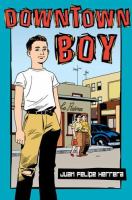
Gr. 5-8. The author of Crash Boom Love0 (2000) offers another stirring novel-in-verse written in the voice of a young Chicano boy. In 1950s California, 10-year-old Juanito is tired of moving with his migrant-worker parents and staying in relatives' homes in San Francisco's Mission District. He aches for his often-absent father. Finally, Papi returns, and home becomes San Diego, where Juanito settles into a deeper sense of place and faces family secrets and hardship. Herrera's free-verse lines make poetry from the sounds and rhythms in everyday life: one passage, for example, juxtaposes the Boys' Club boxers' relentlessly bouncing feet with Juanito's memories of constant movement. Some younger readers may need to talk about a brief, nonexplicit scene in which Juanito evades an apparent pedophile, but many kids will connect with the vivid portrait of a family, the struggles of undocumented immigrants, and a boy's search for the young man he will become: "Sometimes I see a boy / blurry and worried; / sometimes I see a boy / strong and tall." --Gillian Engberg Copyright 2005 Booklist
Gr 7 Up-Herrera's novel in verse tells of a year in the life of 10-year-old Juanito Palomares in late-1950s California. At the mercy of his roving father, the young Chicano reports on his sometimes bleak, yet ultimately hopeful existence. When he and his mother bunk with relatives in San Francisco, his cousin Chacho demands, "You wanna be a chump/or a champ?" to get him to box Sweet Pea Price, and to pursue wild dares at the hospital morgue. His father's return puts him in motion once again. San Diego is his next home, where he continues to change apartments and schools, often just as he begins to look forward to a special event. Flashbacks to the family's time in the state's central farm region, living by picking, show Juanito's guilt at revealing the Garcia family's location to the "green van" immigration officials. The Palomareses demonstrate a wealth of love when Juanito's father loses both legs to complications from diabetes, curtailing his travels. The language varies from prosaic sentences broken into lines of verse to poems quite lyrical, but action is in short supply. Lacking the universal appeal of Sandra Cisneros's The House on Mango Street (Knopf, 1991) and less engrossing than Karen Hesse's Out of the Dust (Scholastic, 1997), this novel perhaps speaks more to adult readers than to young people, who may not feel as much kinship to this boy of their grandparents' generation or before, even if they share his Latino heritage.-Suzanne Gordon, Richards Middle School, Lawrenceville, GA (c) Copyright 2010. Library Journals LLC, a wholly owned subsidiary of Media Source, Inc. No redistribution permitted.


